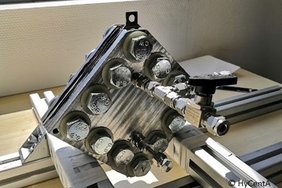ELECTROCHEMICAL COMPRESSOR FOR H2
Current state of the art hydrogen storage systems use compressed hydrogen at common pressure levels of up to 700 bar which are usually provided by mechanical compression technologies.
The compression of hydrogen as a key technology and a current bottleneck in hydrogen plants has been a field of increasing interest in the last few years. State-of-the-art mechanical compressors have high maintenance costs, increased energy demands—especially in the low-pressure range—and pose challenges with complex designs and noisy operation.
Within the HyFacility sub-project, detailed exploration of electrochemical compressors (EHC) is underway, holding high potential to address current challenges. Their reactor design is similar to electrolysis cells, featuring no moving parts for low-maintenance and quiet operation while maintaining high efficiency (> 80 %). Further advantages of the technology are high-purity hydrogen, the flexible adjustment of the flow-rate and the scalability potential.
However, the technology is at a relatively low technology readiness level, requiring specific research on aspects such as H2 back diffusion, membrane cracking at high differential pressures, membrane water balance, suitable sealing concepts, and elevated overvoltages. Developing an optimal stack design and material selection is crucial to overcome these challenges and reduce the currently high costs associated with this technology.
Impact and effects
A crucial milestone in this journey is the single cell testing, which provides compelling evidence of the technology's potential showing an achievable pressure level of 75 bar and more than 50 % isothermal efficiency. Compared to the current state of the art in mechanical compressors, the pressure difference achieved within 1 stage is 10 times higher already at this early stage. The introduction of advanced sealing solutions enables pressure levels beyond the prioritized 100 bar (distribution pipeline pressure).
The single-cell test results will be validated in a short stack prototype showcasing modular, high-efficiency electrochemical compression systems that not only meet the high performance expectations but also pave the way for sustainable and widespread adoption of clean energy solutions.
Highlights
- Compression efficiency from 1 to 75 bar with EHC already higher than with state-of-the-art mechanical compressors.
- More than 10 times higher pressure differences compared to mechanical compressors achieved.
- Further development focus on low input pressure (industrial bottleneck) and pipeline supply pressure (100 bar). In a second step, a multi-stage design for pressures up to 700 bar will be introduced.
Project partner
- AIT, AUT
- AVL, AUT
- BEST Research, AUT
- Fronius, AUT Henn, AUT
- Henn, AUT
- Profactor, AUT
- Postbus, AUT
- TU Graz (CEET, IWT, ITNA), AUT
- Verbund, AUT


